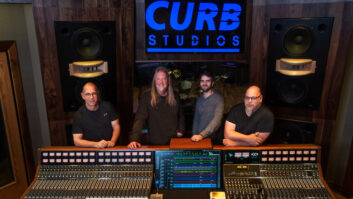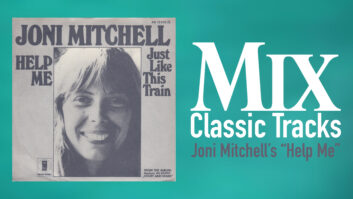
Men on the move (l-r): Braden Stadlman, Wes Schuck and Luke Harper
In our May 2004 issue, Mix spoke with front-of-house engineers and business entrepreneurs who were knee-deep in recording a live show, burning it to CD and selling it to concertgoers 15 minutes after the curtain fell. Taking advantage of consumers’ “bootleg” mentality, the on-the-fly semi-mastered CDs seemed to be a viable and profitable product to sell. However, remote recording company Moving Records is offering a step above: fully mastered CDs still available right after the show.
Created in 2002 by Two Fish Studios’ owner Wes Schuck, mobile recording and distribution company Moving Records (Mankato, Minn.; www.movingrecords.com) affords front-of-house engineers the ability to stay “in the moment” while mixing a show by coming on-site, recording high-fidelity audio and selling it — staying as much out of the FOH’s hair as possible: “After we’ve plugged in, we’re not there,” explains head engineer Luke Harper.
Harper, a self-described studio rat, was a Pro Tools operator at Two Fish for eight years before he jumped into the company’s trailer and hit the road with String Cheese Incident last year. “There’s a huge learning curve and I respected FOH and live engineers a great deal before, but I respect them even more now,” Harper says of making the leap to becoming a live sound engineer. “The time factor is the main issue: It’s gotta be done perfectly and it’s gotta be done now. There’s absolutely zero room for any kind of mistake. When I’m in the studio, I have the luxury of rectifying issues as they come up and dealing with it in a slightly more leisurely pace. When I’m on the road, it’s such a, ‘This must work now and it must work perfectly and you don’t have a second chance.’”
“The other thing about the road that’s different than the studio,” pipes in Braden Stadlman, Moving Records’ bounce engineer and tech partner, “is the sheer amount of variables that we have to deal with: travel, deadlines to get to places, a variety of setups in different venues.”
However, their evolution into becoming live sound engineers was padded by the help of String Cheese Incident’s sound crew, including Peter Dressen and Jon O’Leary, who took Harper and Stadlman under their wings “and really helped us out as far as liaising with them and future FOH people that we’d have to deal with,” Harper recalls.

But where their studio chops are put into play is on the rig’s tech side. “We needed to consider everything, as this is more or less uncharted territory,” Schuck says. “We needed to ‘ruggedize’ and rack the odd assortment of gear that was originally designed for the climate-controlled and permanent install conditions of the studio to keep the gear safe and operational out on the road.”
“We have two ways of [creating CDs],” Harper explains. “We can either take a 32-channel feed — we have a split snake that we can provide — or we can take a 4-channel feed, which we did for String Cheese: two basic mix channels [a left and right] off the main console and then two channels of crowd to retain that live feel. What these do is from FOH or from our split, they go into Apogee AD16 converters and into a CobraNet box, which converts it so we can send it through Cat-5e to our truck.”
According to Stadlman, CobraNet was ideal because of the distances that they found themselves running cable, such as in historic venues or outdoor festivals, and because of the ease of setting up a Cat-5 network, achieving 96k sample rates through it and branching it off as many times as needed through hubs.
Once inside the 35-foot semi-tractor/trailer, signal passes through another CobraNet box via AES/EBU into a Pro Tools system. “That’s where the magic happens,” Harper says, “because we’ve got three Pro Tools|HD 3 systems running at all times to a 2.5-Terabyte Apple Xserve RAID.” Or, according to Stadlman, “one of the most hot-rodded Pro Tools rigs on the planet!”
“Three of them are always on — we’re always directly interfacing with these three,” Harper continues. “I interface with one directly as a mix and master station. I’m using a lot of Waves plug-ins to do my mastering, as well as Filterbank, McDSP and standard Digi stuff. The other two are our bounce stations that Braden’s running [where he breaks each track up into markers, adjusts lead-in and fades and then encodes for CD]. We have another setup that is just a pure backup. All of this is on batteries, so if we had a catastrophic loss of power, we’d still be able to go. So we have learned the joys of UPS redundancy and having massive battery backups. We can be without power for a good 30 minutes and be fine.”
Because Moving Records is using this system and not just a board feed, they are able to go back into a file and change things around. “We can bring up crowd noise retroactive to where we are in the set at that time,” Harper notes. “If they wanted a crowd swell on one song, we can go back and give them a little extra crowd in that one part.” This retroactive mixing is also useful when a band — or their label — is particular about how they want to sound on the finished product.
All three stations are interfaced through Studio Network Solutions’ SANmp, creating a Fibre Channel SAN within the truck so that all three workstations can actively work on the incoming audio to share files — in real time. “This is similar to the system that Studio Network Solutions provided Abbey Road with to mix The Lord of the Rings series,” says Schuck.
“We knew we wanted to be able to record a show at the highest fidelity possible,” Stadlman says. “We also wanted to ensure that we could edit things as we were going so that we weren’t just recording directly to an uneditable media.”
“If we simply hooked a Finalizer up to a CD player,” Schuck emphasizes, “we wouldn’t be able to edit audio or adjust track markers very easily.”
Once the CD is encoded, a disc image is finalized on the computer and transferred via gigabit Ethernet to the duplication nodes (aka kiosks), duplicated on the spot as they come off of Stadlman’s station — about 300 in five minutes — as a two- or three-disc set.
The duplicators were custom-designed by Stadlman. “The drives interface with a controlling computer via a combination of FireWire and IDE technologies,” Harper explains. “Each duplicator contains multiple TEAC and Plextor drives. Multiple duplicators are mounted in custom racks made by Rock Hard Cases. Each rack case makes up one duplication unit. These duplication units are the soul of our distribution kiosks and enable each kiosk to be completely modular. If we need more output at one kiosk location, we can plug in more duplicators there. If we need more dispersed output for an arena-sized event, we can set up more smaller kiosks located further apart to lessen time spent by customers in line. It’s really cool.”
Once the master disc image is downloaded by the controller computer, the duplication process is initiated. Before and after the disc is written, diagnostics are run on each disc to ensure that a disc containing an error is never released. It is only a matter of a couple of minutes before the first run of discs is handed out.
“It’s an exciting new world and the fans love it,” Harper enthuses. “We have had people hug us, we’ve had people screaming at us that this is the most wonderful thing. Tapers love us to pieces because now they can enjoy the show; they don’t have to sit there and monitor their mics.”
“Even the sought-after board recordings,” Stadlman interjects. “This blows them out of the water.”
Future plans for Moving Records include providing a DVD after the show, perhaps even in surround, one of the front-running reasons for producing at 96k. New gear currently being tested for the rigors of the road include the new CobraNet digital audio protocol by Cirrus Logic and free-space optics (open-air laser networks capable of 1000BaseT throughput) for content transfers and sending the final masters to the dupe kiosks. “We have affectionately called the implementation of these new technologies ‘Project Hour Glass,’” Schuck reports, “as it has drastically improved our turnaround time and also describes the web of networked distribution kiosks by bringing to mind the hourglass markings of a Black Widow spider.”
“We’re certainly looking into all of this,” Harper emphasizes. “It’s constant R&D. We’re just waiting for the technology. We will do this if it becomes feasible.”
Sarah Benzuly is Mix‘s senior associate editor.







